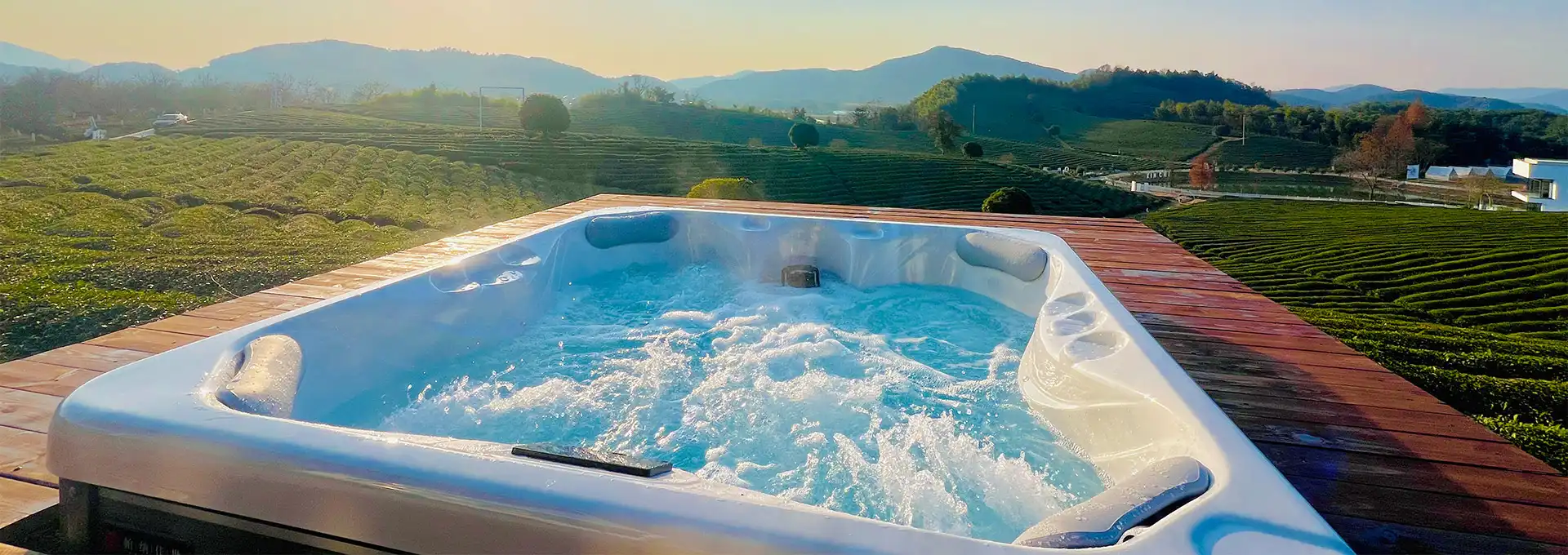How to Install Swim Spa In Ground?
2024-12-19 16:55:56
Installing a backyard swim spa in-ground is an excellent way to enhance your backyard and create a luxurious aquatic retreat. This project combines the benefits of a swimming pool and a spa, offering a versatile space for exercise, relaxation, and entertainment. While the installation process can be complex, understanding the key steps and considerations will help ensure a successful outcome. In this comprehensive guide, we'll explore the essential aspects of installing an in-ground swim spa, from planning and preparation to the final touches.
What are the site preparation requirements for an in-ground swim spa?
Before you begin the installation process, proper site preparation is crucial for the success and longevity of your in-ground swim spa. This phase involves several important steps and considerations to ensure a stable foundation and optimal placement.
First, you'll need to choose the ideal location for your swim spa. Consider factors such as privacy, accessibility, and proximity to utilities. The site should be level and have good drainage to prevent water accumulation around the spa. It's also important to ensure that the chosen location complies with local zoning laws and building codes.
Once you've selected the perfect spot, the next step is to excavate the area. The size of the excavation will depend on the dimensions of your in-ground swim spa, plus additional space for plumbing, electrical components, and insulation. Typically, you'll need to dig a hole that's about 12 inches larger than the swim spa on all sides and deep enough to accommodate the entire unit plus any required base materials.
After excavation, it's crucial to create a solid foundation. This usually involves pouring a concrete slab that's at least 6 inches thick. The slab should be level and reinforced with rebar to prevent cracking. Some installers recommend adding a layer of gravel beneath the concrete for improved drainage.
While preparing the site, you'll also need to consider access for heavy equipment. Ensure that there's a clear path for machinery to reach the installation area without damaging your property or landscaping. If access is limited, you may need to explore alternative installation methods or equipment.
Electrical and plumbing preparations are another critical aspect of site preparation. Work with licensed professionals to install the necessary electrical circuits and plumbing lines. This may include running conduit for electrical wiring, installing a GFCI-protected circuit breaker, and setting up water supply and drainage systems.
Don't forget about ventilation and moisture control. In-ground swim spas can generate significant humidity, so proper ventilation is essential to prevent mold and mildew growth. Consider installing vents or a dehumidification system in the surrounding area.
Lastly, think about the finished look of your swim spa area. Plan for decking, landscaping, and any additional features like lighting or outdoor seating. These elements will help integrate the swim spa seamlessly into your backyard design and enhance the overall aesthetic appeal.
How do you properly insulate an in-ground swim spa?
Proper insulation is a critical factor in the installation of an in-ground swim spa, as it directly impacts energy efficiency, operating costs, and overall comfort. Effective insulation helps maintain water temperature, reduces heat loss, and protects the spa's components from the surrounding soil and moisture.
The first step in insulating your in-ground swim spa is to create a thermal barrier between the spa shell and the surrounding soil. This is typically achieved by applying a layer of high-density foam insulation around the entire exterior of the spa. The foam should be at least 2 inches thick and have a high R-value to provide maximum thermal resistance.
Next, consider installing a vapor barrier to prevent moisture from penetrating the insulation and spa structure. A heavy-duty plastic sheet or specialized vapor barrier material can be wrapped around the foam insulation to create an additional layer of protection.
For the spa's floor, start by laying down a layer of gravel or crushed stone for drainage. Over this, place a sheet of rigid foam insulation before pouring the concrete slab. This will help prevent heat loss through the bottom of the spa and protect against ground moisture.
When insulating the plumbing and electrical conduits, use foam pipe insulation to wrap all exposed pipes and lines. This not only helps maintain water temperature but also protects against freezing in colder climates.
Consider installing a thermal cover for the swim spa when it's not in use. A well-fitted, insulated cover can significantly reduce heat loss through the water's surface and help maintain consistent water temperature.
In regions with extreme temperatures, you may want to explore additional insulation options. Some installers recommend creating an insulated "vault" around the entire swim spa using structural insulated panels (SIPs) or insulated concrete forms (ICFs). This approach provides superior thermal performance and can help extend the usability of your swim spa throughout the year.
Don't forget about the importance of sealing any gaps or penetrations in the insulation. Use expanding foam or caulk to seal around pipes, electrical conduits, and any other openings to prevent air and moisture infiltration.
Lastly, consider the insulation of the swim spa's equipment compartment. While this area needs proper ventilation, it should also be insulated to protect sensitive components from temperature extremes and moisture.
What are the maintenance requirements for an in-ground swim spa?
Maintaining an in-ground swim spa is essential for ensuring its longevity, performance, and safety. While these versatile aquatic features offer numerous benefits, they also require consistent care and attention to keep them in optimal condition.
One of the most crucial aspects of swim spa maintenance is water quality management. This involves regular testing and balancing of the water chemistry to ensure it remains safe and comfortable for use. You'll need to monitor pH levels, alkalinity, and sanitizer levels (such as chlorine or bromine) at least twice a week. Invest in a reliable water testing kit and familiarize yourself with the ideal ranges for each parameter.
Cleaning the swim spa is another important maintenance task. Skim the surface daily to remove debris, and vacuum the floor and walls at least once a week. Pay special attention to the waterline, where oils and other contaminants can accumulate. Use a soft cloth or sponge with a non-abrasive cleaner designed specifically for swim spas to avoid damaging the surface.
The filtration system plays a vital role in maintaining water clarity and quality. Clean or rinse the filters weekly, and perform a deep clean or replacement according to the manufacturer's recommendations, typically every 3-4 months. Ensure that the circulation pump is running for the recommended duration each day to keep the water moving and filtered.
Regularly inspect the swim spa's cover for signs of wear or damage. Clean it monthly with a mild soap solution and apply a vinyl protectant to keep it supple and resistant to UV damage. A well-maintained cover not only improves energy efficiency but also prevents debris from entering the spa when it's not in use.
Pay attention to the spa's equipment, including pumps, heaters, and blowers. Listen for unusual noises, check for leaks, and ensure that all components are functioning correctly. Schedule annual professional inspections to catch and address potential issues before they become major problems.
In colder climates, winterization is an important consideration. If you plan to use your swim spa year-round, make sure to maintain a consistent water temperature and protect exposed plumbing from freezing. If you choose to close the spa for the winter, follow the manufacturer's winterization procedures carefully to prevent damage from freezing temperatures.
Keep an eye on the water level in your swim spa. Evaporation and splashing can cause the water level to drop, potentially exposing skimmers and affecting circulation. Top off the water as needed, using a hose filter to remove impurities from the fresh water.
Periodically check and clean the jets to ensure they're functioning properly and providing the desired hydrotherapy experience. Remove and soak them in a cleaning solution if necessary to remove any buildup of minerals or debris.
Lastly, establish a regular schedule for draining and refilling your swim spa. Depending on usage and water quality, this may be necessary every 3-4 months. Use this opportunity to thoroughly clean the spa shell and perform any needed maintenance on the plumbing or equipment.
Conclusion
Installing an in-ground swim spa is a significant investment that can greatly enhance your outdoor living space and provide years of enjoyment. By carefully considering site preparation, insulation, and ongoing maintenance requirements, you can ensure that your swim spa performs optimally and remains a cherished feature of your home. Remember to consult with professionals for complex tasks and always prioritize safety throughout the installation and use of your in-ground swim spa.
For more information on hot tub installations and to find out more about our products, please feel free to contact us at info@iparnassus.com.
References
- Swim Spa Guide. "In-Ground Swim Spa Installation."
- Pool and Spa News. "Installing In-Ground Swim Spas."
- Aqua Magazine. "The Ins and Outs of In-Ground Swim Spa Installation."
- Home Stratosphere. "How to Install an In-Ground Swim Spa."
- Swim University. "How to Maintain a Swim Spa."
- Bullfrog Spas. "Swim Spa Installation Guide."
- Master Spas. "In-Ground Swim Spa Installation Tips."
- Poolonomics. "Swim Spa Maintenance: The Ultimate Guide."
- Spa Depot. "Swim Spa Insulation Techniques."
- Swim Spa Expert. "Site Preparation for In-Ground Swim Spas."
Send Inquiry
Related Industry Knowledge
- Will Medicare Pay for a Swim Spa?
- How Much Electricity Does a Hot Tub Use?
- How Many Gallons is My 6 Person Swim Spa?
- Are Hot Tubs Good for Osteoarthritis?
- What Chemicals Are Needed for a Swim Spa?
- How to construct a vault for underground swim spa?
- Can I Add Foam to Hot Tub?
- What Are the Maintenance Requirements For a 7 Person Swim Spa?
- How Heavy is a 5 Person Hot Tub?
- How Often to Chlorinate a Swim Spa?



